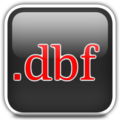| Extension | File content |
|---|
| .DBF | Database file |
| .DBK | Database backup file |
| .DBO | Command and procedure object file |
| .DBT | Database memo file |
| .DEF | Selector definition file |
| .DEM | Define statements for a CUA form |
| .DIF | Data Interchange Format, or VisiCalc file; used with APPEND FROM and COPY TO |
| .DOC | Documentation file; Applications Generator only |
| .ERR | Created if an error occurs during form generation, or if an unrecoverable error occurs |
| .FIL | Files list design object file |
| .EMO | Compiled format (.fmt) file |
| .FMT | Generated format file; from .scr file |
| .FNL | Report binary name list file |
| .FR3 | Renamed old dBASE HI report form (.frm) file |
| .ERG | Generated report form file; from .frm file |
| .FRM | Report form file |
| .FRO | Compiled report form (.ERG) file |
| .FW2, .FW3, .FW4 | Framework spreadsheet or database file; used for import and export |
| .GEN | Template file |
| .GRP | Windows group file for dBASE for DOS |
| .HLP | dBASE for DOS help files |
| .ICO | dBASE for DOS icon file under Windows |
| .INI | Windows-like INI file to save Label Designer and IDE state information. |
| .KEY | Keystroke macro library file |
| .LB3 | Renamed old dBASE III label form (.LBL) file |
| .LBG | Generated label form file; from .LBL file |
| .LBL | Label form file |
| .LBO | Compiled label form (.LBL) file |
| .LOG | Transaction log file |
| .LNL | Label binary name list file |
| .MBK | Multiple index backup file |
| .MDX | Multiple index file |
| .MEM | Memory file |
| .NDX | Single index file |
| .OVL | dBASE for DOS overlay file |
| PIF | Microsoft Windows file for non-Windows applications |
| .POP | Pop-up menu design object file; Applications Generator only |
| .PR2 | Printer driver file |
| .PRD | A file containing printer driver information for DBSETUP |
| .PRF | Print form file |
| .PRG | dBASE command or procedure file |
| .PRS | dBASE SQL command or procedure file |
| .PRT | Printer output file |
| .QBE | QBE query file |
| .QBO | Compiled QBE query (.QBE) file |
| .QRY | dBASE El query file |
| .RES | Resource file |
| .RPD | RapidFile file; used for import and export |
| .SC3 | Renamed old dBASE III screen (.SCR) file |
| .SCR | Screen file |
| .SNL | Screen binary name list file |
| .STR | Structure list design object file; Applications Generator only |
| .T44/.W44 | Intermediate work files; used by SORT and INDEX |
| .TBK | Database memo backup file |
| .TXT | ASCII text output file |
| .UPD | QBE update query file |
| .UPO | Compiled QBE update query (.UPD) file |
| .VAL | Values list design object file; Applications Generator only |
| .VMC | Configuration file; for Virtual Memory Manager (VMM) |
| .VUE | View file |
| .WIN | Logical window save file |
| .WKS, .WK1 | Lotus 1-2-3 file; used with APPEND FROM and COPY TO |
